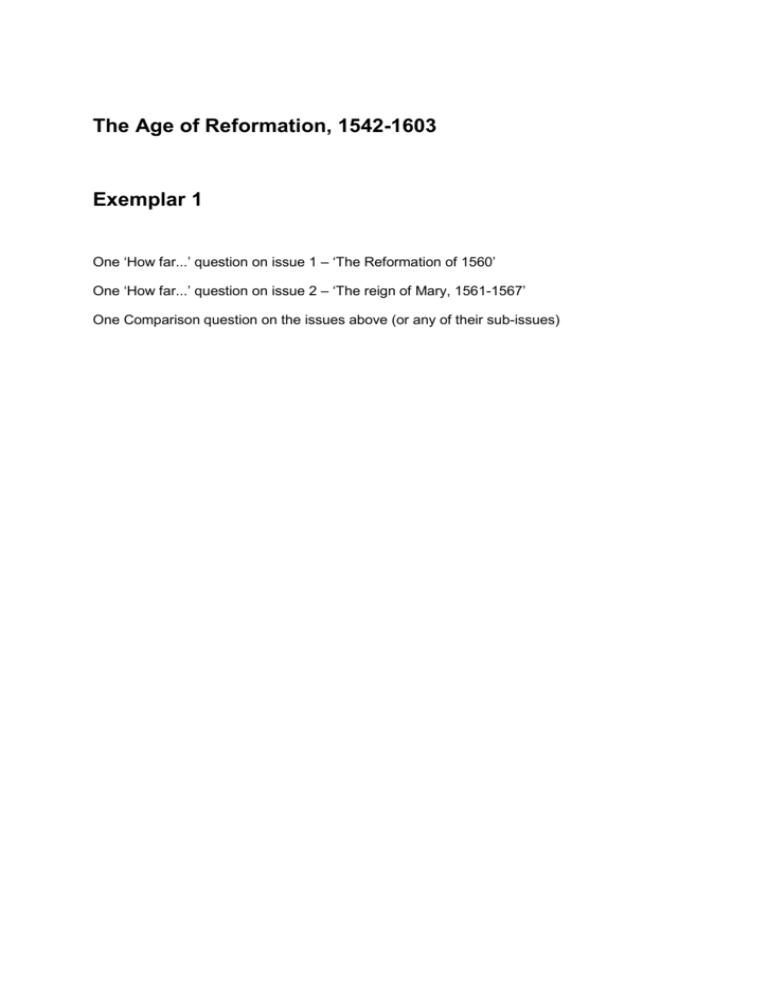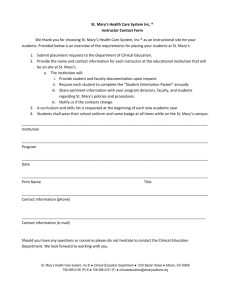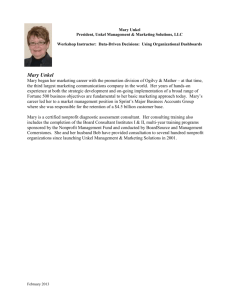The Age of Reformation, 1542 -1603
advertisement

The Age of Reformation, 1542-1603 Exemplar 1 One ‘How far...’ question on issue 1 – ‘The Reformation of 1560’ One ‘How far...’ question on issue 2 – ‘The reign of Mary, 1561-1567’ One Comparison question on the issues above (or any of their sub-issues) 2. The Age of Reformation, 1542-1603 Study the sources below and then answer the questions which follow Source A: from Ian B. Cowan, The Scottish Reformation (1982) For a time in August 1559 when four French ships arrived at Leith the final outcome remained uncertain. But it was noted that fear of continued French supremacy encouraged even proCatholic magnates to join the Congregation. In turn, this led to an appeal for effective military intervention by the English. Elizabeth was finally to respond to this request in March 1560. This was fortuitously followed by the death of Mary of Guise, in June. These two factors proved to be decisive. A campaign which the Congregation and their Protestant supporters could never have won by their own efforts was successful. The Treaty of Edinburgh between France and England in July 1560 guaranteed the end of French influence in Scotland, and in the parliament that followed, the victorious Protestant lairds accepted a reformed Confession of Faith. To what extent political reasons engineered the aceptance of the new Protestant faith must remain debatable. Source B: from Antonia Fraser, Mary Queen of Scots (1985) Ever since the murder of Riccio, Mary had made it clear that she wished to be rid of Darnley. She made two further points of vital interest to her. First, that her child must not run the risk of illegitimacy, and second that her ‘honour’ was not to be challenged. Mary, however, did not examine the situation so clearly in her own mind. She was a queen and a woman and as a woman she wished to be rid of an intolerable marital situation. As a queen she expected her nobles to help her to solve this difficult governmental problem. There could be no benefit to her for thinking too far or too early into how the nobles proposed to carry out her wishes. If Moray intended to ‘look through his fingers’, Mary intended to keep her own hands tightly across her eyes. Source C: from Rosalind K Marshall, John Knox (2000) On returning to Scotland in August 1561, Mary issued a statement emphasising her desire for an end to religious dissension. In the meantime no one was to disturb the current situation. In other words, Protestants were free to continue their services and she would have her Mass. The Sunday after Mary’s first Mass at Holyrood, Knox preached strongly against Catholicism to a large congregation in St Giles. One Mass was more fearful to him than an invasion of a foreign army of ten thousand with the aim of suppressing the whole religion, he said. Some of the nobles in the congregation mocked what Knox said, but Lord James Stewart (Mary’s halfbrother and later Earl of Moray) and his friends were seriously annoyed. Publicly condemning her Mass was not the way to guide Mary towards Protestantism. Source D: from A. Weir, Mary, Queen of Scots and the Murder of Lord Darnley (2003) As a young Catholic queen in a turbulent land, Mary faced challenges that would have defeated a far more experienced ruler. In an age of religious intolerance, her willingness to compromise seemed suspect, but Mary professed tolerance of the new faith in Scotland in order to ensure her political survival. Although personally devout, she did little to champion the Catholic cause in Scotland during her reign. Her private attendance at Mass gave rise to much resentment, and initially there were even riots to protest against it. Lord James ensured her security, kept the turbulent nobility in check and took her part against the disapproving Knox. However, Mary repeated her undertaking not to tamper with the Protestant religion and made generous grants to the Kirk. She even received some instruction in Calvinist doctrines, but none of this satisfied her critics. Questions Marks 1 How far does Source A illustrate the influence of England and France on religious developments in Scotland? Use the source and recalled knowledge. 2 How far does Source B illustrate the contribution Mary Queen of Scots, made to the loss of her own throne? Use the source and recalled knowledge. 3 10 10 To what extent do Sources C and D agree about Mary’s difficulties in ruling Scotland? Compare the sources overall and in detail. 5 Marking Instructions Question 1 How far does Source A illustrate the influence of England and France on religious developments in Scotland? 10 The candidate makes a judgement on how far Source D illustrates the influence of England and France on religious developments in Scotland in terms of: Points from the source which show the candidate has interpreted the significant views: Fear of continued French supremacy encouraged even pro-Catholic magnates to join the Protestant Congregation. Fear of continued French supremacy led the Protestant Congregation to appeal for English military intervention which was granted in March 1560. The death of Mary of Guise in June 1560 was a decisive factor as she was responsible for French supremacy up to that point . The Treaty of Edinburgh between France and England guaranteed the end of French influence in Scotland and victory for the Protestant Lords of the Congregation. Points from recall which support and develop those in the source: The English had encouraged Protestant ideas in Scotland in the 1540s: English troops had distributed Protestant literature and Henry VIII had bribed Scots nobles during the period of the ‘Rough Wooing’. The Protestants had expected help from the English during the siege of St Andrews but received none leading to their defeat. From 1558 Scottish lords joined the Lords of the Congregation and Protestants began to meet for worship using the English prayer book. In 1560 the Lords of the Congregation were not strong enough to drive out the Catholic French on their own. Elizabeth gave supplies and military and financial support to the Lords of the Congregation. Mary of Guise’s prosecution of Protestant reformers (carried out on the advice of the Pope) led reformers to seek help from England. The presence of Catholic French troops in Scotland had become increasingly unpopular. Points from recall which offer a wider contextualisation: After the failure of international discussions, the death of Mary of Guise led to Scotland becoming a Protestant country. After Mary of Guise’s death, no Catholic leaders emerged and a political vacuum was created. Scotland still had a Catholic Queen who lived in France although she did nothing to oppose the Reformation in Scotland. The Reformation Parliament brought in the Scottish Reformation Any other relevant points. Question 2 How far does this Source B illustrate the contribution Mary Queen of Scots, made to the loss of her own throne? 10 Points from the source which show the candidate has interpreted the significant views: Ever since the murder of Riccio, Mary wanted to be rid of Darnley. In Mary’s mind, any solution to her marriage problems could not lead to her child being declared illegitimate. As a Queen she wished to influence her nobles to assist her by solving her problem. In keeping ‘her own hands tightly across her eyes’, Mary chose to remain ignorant of her nobles’ plans. Points from recall which support and develop those in the source: From the outset the Scottish nobility were wary of Mary as a Catholic and a woman. Mary’s marriage to Darnley and his demands for the ‘Crown Matrimonial’ were unacceptable to the queen. Mary pardoned Riccio’s murderers aware that they might join a conspiracy against her husband, Darnley. The birth of a son provided her opponents with a potential replacement for Mary. Points from recall which offer a wider contextualisation: The Chaseabout Raid in 1565 resulted from Mary’s marriage and though she kept control, she lost the support of many powerful and influential men. Mary’s attendance at Privy Council meetings was poor and by 1564 her attendance had dropped to only five out of fifty meetings. In 1560 when Scotland was declared Protestant by Parliament, Mary remained a Catholic. Mary isolated herself from her nobles and surrounded herself with French servants. It was suspected by many that Mary was implicated in Darnley’s murder. Mary, with undue haste, married Bothwell who was not popular with many of the nobles, and the prime suspect at the time of Darnley’s murder at Kirk o’ Field. Her obsession with the claim to the English throne aroused suspicion rather than assistance of Elizabeth I. Any other relevant points. Question 3 To what extent do Sources C and D agree about Mary’s difficulties in ruling Scotland? 5 The candidate makes a judgment on how far Sources C and D agree about the difficulties Mary faced in ruling Scotland in terms of: Overall Sources C and D agree that Mary faced considerable difficulties in ruling Scotland. Points from Source C Mary issued a statement emphasising her desire for an end to religious strife Protestants were free to continue their services After Mary’s first Mass at Holyrood, Knox preached against Catholicism to a large congregation in St Giles Lord James Stewart (her halfbrother, later Earl of Moray) and his noble friends wanted to guide Mary towards Protestantism Points from Source D Mary professed tolerance of the new faith in Scotland Mary repeated her undertaking not to tamper with the Protestant religion Mary’s private attendance at Mass gave rise to much resentment, and there were riots to protest against it Lord James maintained Mary’s security by influencing the Protestant Lords – keeping the ‘turbulent nobility in check’





